Distributed Development in a Team
Overview
Next Design enables distributed development within a team by splitting models and profiles into separate files.
The following explains how to use the following Next Design features.
| Next Design Features | Overview |
|---|---|
| Splitting and Merging Model Files | Splitting a model within a project into multiple model files enables parallel development within a team. |
| Register Model File | Registering a split model file in another project allows you to share and edit the model file with another project. |
| Export Model File | Exporting a split model file allows you to reuse part of a model in another project. |
| Partial Loading of Model Files | Switching between automatic and manual loading for each split model file prevents unnecessary model file loading and shortens the loading time of large projects. |
| Splitting and Merging Profiles | Splitting a profile from a project allows you to manage models and profiles separately. |
Dividing and Merging Model Files
Dividing into Model Files
To divide a model in a project into multiple model files, follow these steps:
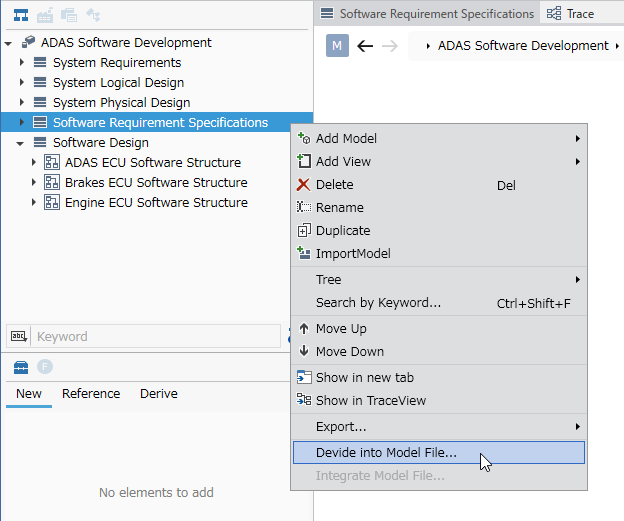
- In the Model Navigator, select the model you want to divide into model files.
- Use one of the following methods to divide into model files:
- Click [Team Collaboration] > [File] > [Devide into Model File] from the ribbon.
- Click [Devide into Model File] from the context menu.
- If you are dividing only one model into a model file, specify the file name in the [Devide into Model File] dialog box.
(If you select multiple models and divide them into model files, you cannot change the file name.) - Specify a save folder in the [Devide into Model File] dialog box and click the [OK] button.
The folder you specify must be a folder under the [Models] folder in the same folder as the project file. - Once split into model files, the model will be marked with an icon indicating the model file.
The model will then be stored as an nmdl (for JSON format) or imdl (for database format) file in the specified folder.
- Only models with the [Allow model file splitting] checkbox checked in the metamodel can be split into model files.
- If the [Devide into Model File] menu is disabled, check the metamodel definition for that model.
Integrating Split Model Files
To integrate split model files into a project, follow these steps:
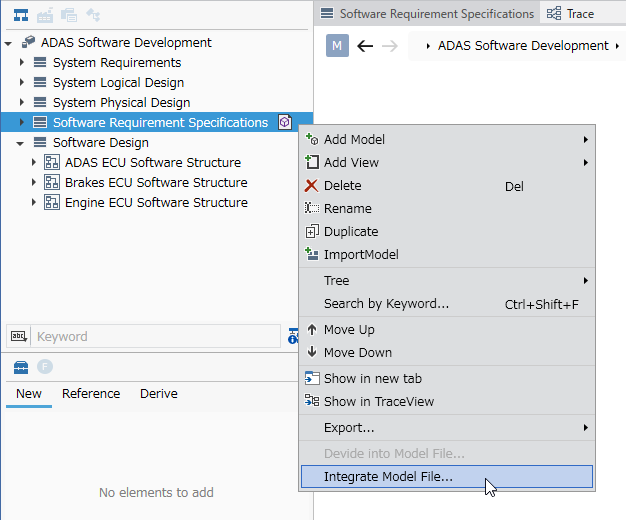
- Select the split model file in the Model Navigator or Project Navigator.
- Integrate the model file using one of the following methods:
- Click [Team Collaboration] > [File] > [Integrate Model File] from the ribbon.
- Click [Integrate Model File] from the context menu.
- Check the confirmation dialog and click the [OK] button.
- Once the model file is integrated into the project, the icon representing the model file will disappear from the model.
Registering a Model File
There are three ways to register a model file:
- Register: Register the model file as a model in your project.
- Import: Copy the model file into your project and register it.
- Reference Registration: Registers a model file so that it can be shared and edited with another project.
The type of registration is determined by the model file's storage location.
- Registration: Under the [Models] folder in the same folder as the project file.
- Import: A folder other than the [Models] folder. If you select [Import] in the dialog box that appears when specifying that folder.
(The model file will be copied to the folder selected when registering the model file.) - Reference Registration: A folder other than the [Models] folder. If you select [Reference] in the dialog box that appears when specifying that folder.
(The model file will be displayed directly under the [Model] folder.)
- Make sure that the project that created the model file you are registering reuses a modularized profile. If you are reusing a profile, refer to Profile Definition > Profile Operation > Output Compatibility Information to Model File and configure the setting to output compatibility information to the model file.
For information on reusing profiles, see the following: - Profile Definition > Profile Operation > Reusing Profile
To register a model file, follow these steps:
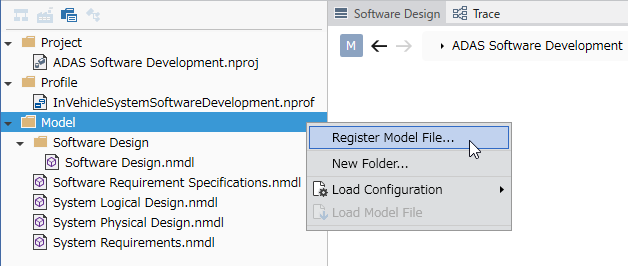
- Open the project to which you want to register.
- Switch to [Project Navigator] in the selector at the top of the Navigator.
- Select [Model] or a folder under [Model] at the top level of the tree.
- Register the model file using one of the following methods:
- Click Team Collaboration > File > Register from the ribbon.
- Click Register Model File from the context menu.
- In the Register Model File dialog box, select the model file (.nmdl or .imdl) and click the Open button.
- If the selected model file is stored outside the Models folder in the same folder as the project file, the Register Model File dialog box will appear.
In the Register Model File dialog box, select Import or Reference. - The model file will be added to the Project Navigator, and the model will be added to the Model Navigator.
- The file save format of the project to which it is registered and the model file to be registered must be the same.
- The profile of the project to which you are registering must be the same as (or include) the profile that created the model file you are registering. If they are not the same, the design information will not load correctly. A warning message will indicate which design information is no longer available.
- If you are registering a model file by reference, the profile must be the same as (or include) the profile of the project that is sharing and editing that model file. If they are not the same, the design information of the model file will not load correctly. If you save the project in this state, design information saved in another project that is sharing the model file may be lost.
- For information on exporting and importing profiles, see the following:
- Profile Definition > Profile Operation > Operation Flow
Export Model File
To export a split model file from a project, follow these steps:
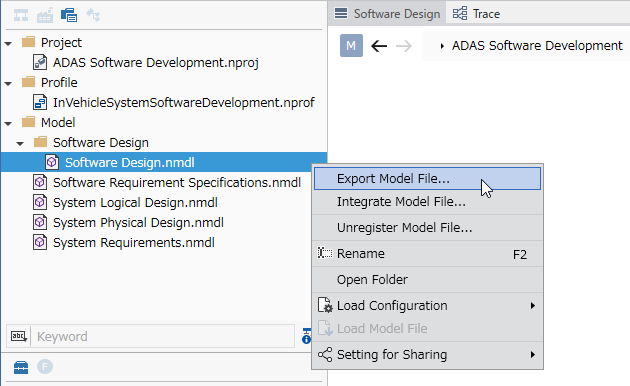
- Switch to [Project Navigator] in the selector at the top of the Navigator.
- In the Project Navigator, select the model file to export.
- Export the model file using one of the following methods:
- Click [Team Collaboration] > [File] > [Export] from the ribbon.
- Click [Export Model File] from the context menu.
- Select the destination folder and click the [Save] button.
- The split model files will be exported and stored in the selected folder.
- To import the exported model file into another project, the profile must be the same.
- See the following for details.
- Profile Definition > Profile Operation > Operation Flow
Moving Model Files
You can move the storage location of model files in the Project Navigator. To move them, follow these steps:
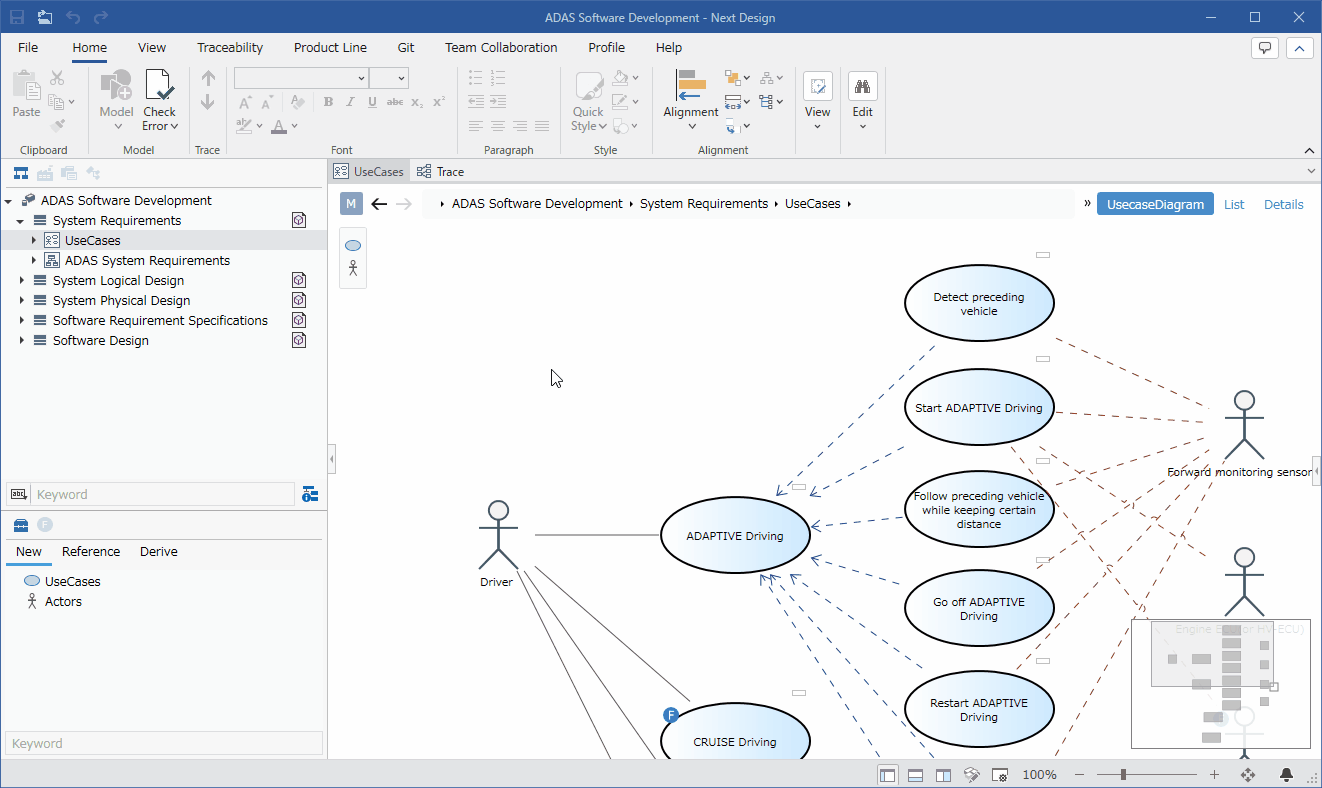
- Switch to [Project Navigator] using the selector at the top of the Navigator.
- Drag the target model file in the tree and drop it into the destination folder.
- You can change the destination folder structure from the context menu of the folder under [Model], which is displayed at the top level of the tree.
- Folders that do not contain model files registered in the project will not appear in the Project Navigator.
If you create a folder in the Project Navigator but do not store a model file in it, the folder will not appear the next time you open the project. - Reference-registered model files cannot be moved in the Project Navigator.
- Save the project after changing the hierarchy or name of a model file.
If you close the project without saving, the change to the model file path will not be saved, and the model file will not be loaded the next time you open the project. - Moving a model file, renaming a file, or deleting a folder cannot be undone.
- If you move a model file using a tool other than Next Design, the model file will not be loaded.
Partially Loading Model Files
Setting Model Files to Manual Load
To set a model file to manual load, follow these steps:
- In the Project Navigator, select the model file you want to switch to manual load.
- From the context menu, select [Load Configuration] > [Set Manual Load].
- An icon indicating manual loading will appear to the right of the model file node.
- The next time you open the project, that model file will no longer be automatically loaded.
Returning a model file to autoloading
To return a model file to autoloading, follow these steps:
- In the project navigator, select the model file you want to switch to autoloading.
- From the context menu, select [Load Configuration] > [Set Auto Load].
- The icon indicating manual loading will disappear from the right of the model file node.
- The next time you open the project, that model file will be automatically loaded.
Loading a model file set to manual loading
When you open a project, model files set to manual loading will be in an unloaded state. To manually load an unloaded model file, follow these steps:
- In the project navigator, select the model file you want to manually load.
- Select [Load Model File] from the context menu.
- The model file will be loaded.
- Model files set as manual nodes are indicated by an "M" icon in the project navigator.
- Model files that have not yet been loaded are indicated by a grayed-out model file name in the project navigator.
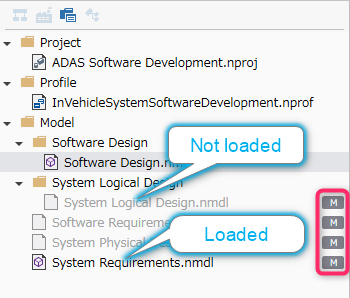
- You can perform the following operations simultaneously for all model files under a folder in the project navigator.
- Load Settings
- Load Model File
This operation is performed from the folder's context menu.
- For details about partially loading model files, see the following:
- Reference > Partial Loading of Model Files
Splitting and Merging Profiles
Splitting a Profile from a Project
To split a profile into files, follow these steps:
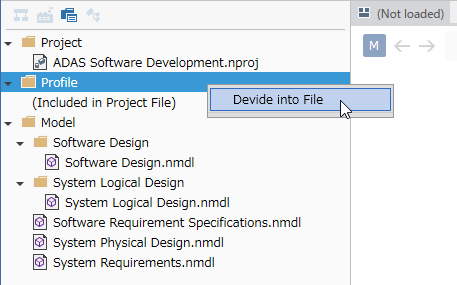
- Switch to [Project Navigator] using the selector at the top of the Navigator.
- Select [Profile] at the top level of the tree.
- Click [Devide into File] from the context menu.
- Once the profile has been split into files, they will be stored as .nprof or .iprof files in a [Profile] folder in the same folder as the project file.
- Do not replace a profile split into files (.nprof or .iprof file) with a profile edited in another project.
- When reflecting a profile from another project, follow the instructions below.
- Profile Definition > Profile Operation > Operation Flow
Integrating a profile split from a project
To integrate a profile into a project, follow these steps:
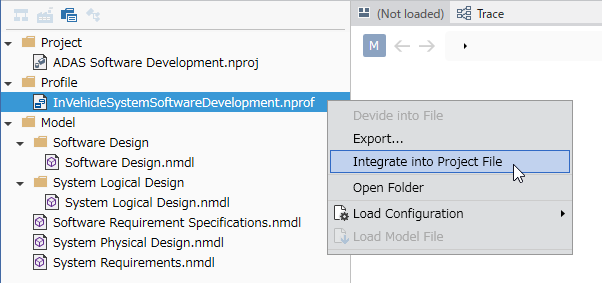
- Switch to [Project Navigator] in the selector at the top of the Navigator.
- Select the profile split into files.
- Click [Integrate into Project File] from the context menu.
- Once the profile is integrated into the project, the .nprof or .iprof file in the Profile folder will also be deleted.